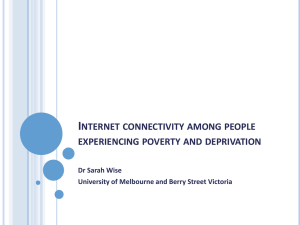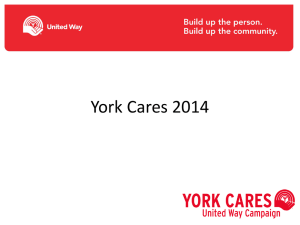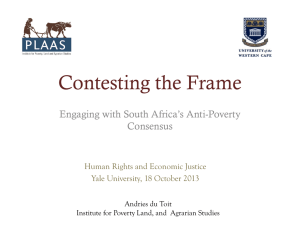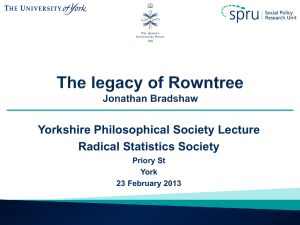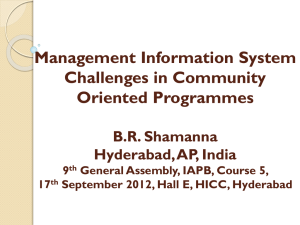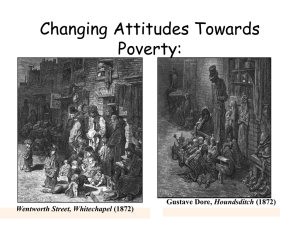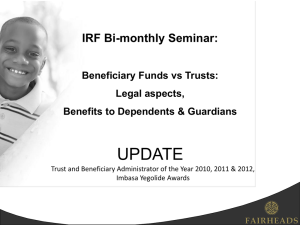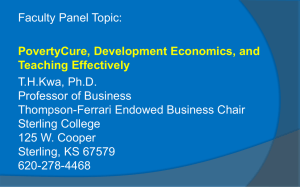dominica_presentation_dominica
advertisement
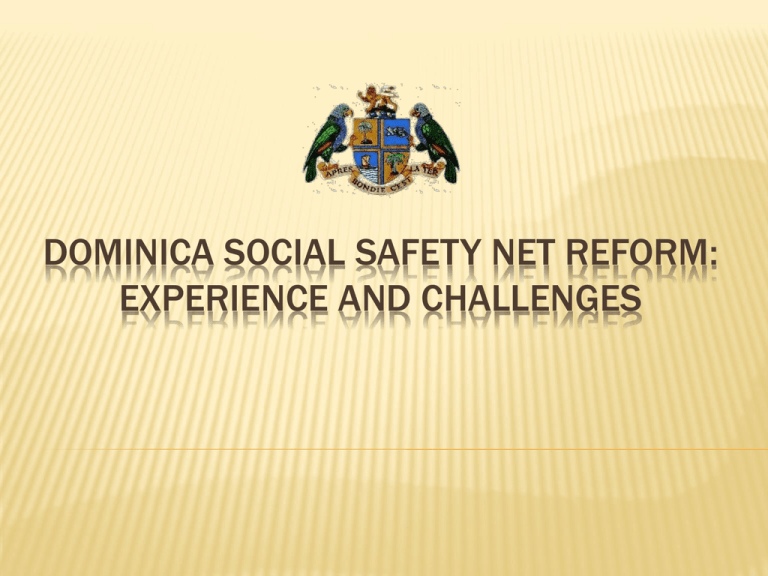
DOMINICA SOCIAL SAFETY NET REFORM: EXPERIENCE AND CHALLENGES COUNTRY PROFILE COUNTRY PROFILE: Largest Windward Island Situated between Guadeloupe and Martinique Total land area of 750.6 km2 (290 sq. miles) Population (CSO Census 2001): 71,079 Least populated Windward Island Susceptible to landslides and vulnerable to hurricanes Very rugged and steep terrain Agriculture & tourism based economy BACKGROUND INFORMATION OF CBR AND MIS BACKGROUND INFORMATION: The Management Information System (MIS) is guided by the World Bank Growth and Social Protection Technical Assistance Project. Origin of Component: Poverty Assessment Report Social Protection Review, 2003 Growth and Social Protection Strategy – Policy Document Public Sector Reform Strategy COMPONENTS OF THE GENERAL PROJECT Making the public sector more effective Customs modernization, Registry modernization, Audit General and Accountant General office, Procurement Legislation Improving the investment climate – Investment strategy and Action plan for Invest Dominica Authority (IDA) COMPONENTS OF THE GENERAL PROJECT Reforming the Regulatory framework for the energy sector – Independent Regulatory Commission (IRC), Legislation for Alternative Energy Improving Social Protection – Beneficiary Identification System, Central Beneficiary System, Management Information System, Public Information Campaign BACKGROUND INFORMATION: According to the Social Protection Review : “The social protection system will assist individuals, households and communities to better manage risk factors and expand coverage to vulnerable groups” BACKGROUND INFORMATION: Critical issues articulated by the GSPS non-transparent targeting of beneficiaries weak capacity to monitor and evaluate programs lack of established policies and procedures implementation of social safety net programs…. The systems needed to be strengthened for OVERVIEW OF THE REFORM OVERVIEW OF REFORM: The objective of the reform is to: improve the efficiency and effectiveness of existing social safety net programs. design and implement an efficient and transparent targeting mechanism that would be used for a number of safety net programs. establish and document all operating procedure for Public Assistance and the Education Trust Fund. develop a central beneficiary registry. RATIONALE OF THE PROGRAMME RATIONALE: To address constraints in the delivery of social safety net programs as identified in the 2003 Dominica Social Protection Review and the Government’s Growth and Social Protection Strategy. Weak capacity to monitor and evaluate programs. Overlap of established policies and procedures for implementation of social safety net programs. Duplication of skills training and community based programs. RATIONALE: CONT’D To reassess beneficiaries of programmes. safety net To develop a uniform proxy means test, which will be used to identify beneficiaries for all major programmes under the social safety net. MAIN OBJECTIVE OF THE SOCIAL PROTECTION COMPONENT To strengthen the Government’s capacity to better target, plan and administer social assistance programs for poor and vulnerable persons. EXPECTED OUTCOMES To enhance the Government’s effectiveness to deliver public goods and services by strengthening the institutional capacity to key agencies. To provide targeted social assistance to reduce poverty. OTHER EXPECTED OUTCOMES: Improved distribution of benefits to the poor. Strengthen delivery of programmes and increased benefit levels. Reduction in time costs for the poor through the merging of programmes with the same objectives and target groups. OTHER EXPECTED OUTCOMES: CONT’D A technical, objective, equitable and uniform mechanism for selecting beneficiaries of targeted social programs. Programme databases to track beneficiaries and expenditures for Public Assistance Programme, Education Trust Fund and the School Feeding Programme. The development of a Central Beneficiary Registry. The Establishment and documentation of policies and procedures for the Public Assistance Programme and Education Trust Fund. PROCESS TAKEN: Develop and Pilot the Proxy-Means Test for the Beneficiary Identification System Plan for the Beneficiary Identification System and Central Beneficiary Registry PROCESS TAKEN: CONT’D Development of a Growth and Social Strategy White Paper in keeping with the Millennium Development Goals. Establishment of a Project Coordinating Unit A Committee was put in place to develop the ToRs for the MIS The ToRs were advertised locally and internationally through newspaper, and internet requesting consultants A subcommittee was established and convened to reviews the proposals submitted by the consultants Consultant was chosen. HIGHS: Establishment of committees Development of a Proxy Means Test Approved by the Cabinet of the Government of Dominica and launched in February 2011 Funding made possible by EU, World Bank and the Government of Dominica Full support of the ICTU LOWS: Consultants did not stick to design specification Double payments per household due to Smart Stream (Financial Management System) not linked to NBIS. Approved allowances goes in the name of Head of Household who may be employed and not in the name of the applicant. Assessments sometimes result in the cancelation disqualification of elderly persons who are generally in need. A Unit is needed to manage the activities of the MIS (Monitoring and Evaluation) or ISSUES SURROUNDING CBR & MIS ESTABLISHMENT : Lack of understanding of CBR and MIS objectives by stakeholders (Government) and consultant. The Committee should have comprised of persons from the private and public sectors. Lack of consultation with the general public on the reform initiatives especially with regards to the CBR and the MIS. There was no stakeholder consultant on the system design of the MIS. It is necessary to have someone with Information Technology background on the committee from the inception. THE NBIS ADVISE TO OECS PARTNERS Ensure the “buy in” of political directorates Have the support of all stakeholders Have a champion Ensure that design specification is properly outlined Establish a Management Unit for further support THANK YOU. Third Caribbean Workshop on Social Protection and International Cooperation Program Registration Form COMMONWEALTH OF DOMINICA TITLE OF THE EXPERIENCE (POLICY, PROGRAM OR PROJECT) Adopt a Family BACKGROUND INFORMATION Governments in developing countries have experimented with a wide range of social protection programs, including those that protect poor people from financial crises. The 2009 Country Poverty Assessment report found an overall reduction in poverty at a national level from 39 per cent in 2003 to 28 per cent in 2009 BACKGROUND INFORMATION Whereas this is a positive indication, the next logical step is to develop programmes to reduce the severity of poverty in some cases and improve the quality of life for persons falling within the 28 per cent bracket. It is also extremely necessary to address the 3.1 per cent deemed indigent, and the 11 per cent identified as being vulnerable. BACKGROUND INFORMATION The parishes needing almost immediate attention because of the severity of poverty experienced by its inhabitants were identified. These parishes are St Joseph, St George, St Andrew and St Patrick. BACKGROUND INFORMATION The Social Welfare Division has been mandated to coordinate government’s main Cash Transfer programme through its Public Assistance programme from its inception which caters for vulnerable individuals and groups in an effort to enhance their quality of life. Much emphasis is placed on working with families as varied services are extended to both adults and children BACKGROUND INFORMATION The Adopt a Family project is aimed at reaching beneficiaries of the Division’s Public Assistance programme in selected urban poor communities within the parish of St. George. The poverty ranking categories of those who fall in the lower quintile (poor & indigent) will be given prime consideration. Due observations have been made as it relates to the status of the urban poor as compared to the rural poor. GENERAL OBJECTIVE 1. 2. 3. The objective of the project is to establish a link between the private sector and the poor and indigent beneficiaries on Public Assistance Programme coordinated by the Social Welfare Division. It is intended to promote the sustainable educational development of children within the poor and indigent households who are in the formal education system, through improved financial and kind support for assisting in breaking the cycle of poverty among this populace. To ensure that children within these households who enters the formal school system attain graduate status and do not have to dropout for lack of support during their educational tenure PROGRAM/PROJECT IMPLEMENTATION TIMEFRAME Starting date: January 2014 (Spring Semester) (Estimated) ending date: Summer 2019: It must also be borne in mind the form the student is at the time of enrolment in the project will determine their duration in the project. PROGRAM/PROJECT IMPLEMENTATION STATUS The project is in its planning stage building on the findings of the Ministry of Finance report on Community Meetings exploring poverty reduction and improvement in the quality of life as a result of the Country Poverty Assessment report. TOPICS Conditional cash transfers Solidarity pensions Food security √ Financial inclusion Income generation Social housing Economy of care √ Gender equity Comprehensive child care Differential attention (minorities, ethnic groups, vulnerable groups) √ Other (please specify) – Educational Assistance IMPACT AREAS National √ Name of the Institution: Ministry of Social Services Departmental (S/S;EDU. HEALTH & Finance) Department(s) Social Welfare Division Municipality(ies) Community/county/sector 3: Gutter, Taris Pit, Yam Piece TARGET POPULATION Child √ 2. Women √ 3. Youth √ 4. Ethnic Groups √ 5. Adults √ 6. Others) 7. Older Persons √ (Please specify) While the programme will seek to target the education pursuit of the Children of school age in the home, the entire family is expected to benefit. Health, psychosocial skills, Income generation 1. EXPERIENCE COMPONENTS Targeting tools Beneficiaries registration systems Monitoring and evaluation practices Interagency and/or intersectoral coordination Community participation methodologies Poverty measurements √ Other? MAJOR ACHIEVEMENTS 1. The concretized information obtained through needs assessment during Ministry of Finance community meetings 2. The initial commitment of the management of Small Business department in collaborating with the Social Welfare Division III. PROGRAM/PROJECT DESIGN AND IMPLEMENTATION The Ministry of Community Development, Social Service and Gender Affairs through the Social Welfare Division is the implementing agency. The Ministry of Finance FOLLOW UP AND MONITORING This project will be monitored through key indicators in keeping with aims and objectives of the project: 1. A reduction in the number people in the said area requesting Public Assistance 2. Education: Possible increase in students graduating out of High schools 3. Nutrition: Improvement in the dietary intake 4. Employment: An increase in the percentage of people who are now more employable 5. Housing: Improving in the living conditions of these households IV. OUTCOMES, IMPACT AND SUSTAINABILITY Indicator Target Attained Goal Increase in School attendance All students from 50% decrease in school drop out grade k (primary) – 4th Formers of all Secondary schools Improved diet All members of the More focus students during lessons household with particular focus on the children Improved Health All member of the household Reduction in communicable and non‐communicable diseases REPLICABILITY AND EXCHANGE POTENTIAL The Government of the Commonwealth of Dominica has been sharing a partial concept of this project for decades through it scholarships and bursary programmes to successful students upon sitting the National Assessment for entry into Secondary schools. The difference with the Adopt-A-Family Project and the one operated by Government will be on ‘performance level.’ REPLICABILITY AND EXCHANGE POTENTIAL Whereas Government’s continuous sponsorship is conditioned greatly on of the receipient’s performance level, meaning if the beneficiary repeated any given class, the sponsorship would be automatically terminated. The Adopt-A-Family project is aimed at sponsoring a child in bringing them to the point of completing a secondary education and where possible, tertiary. This is whether or not they repeated any of their classes. REPLICABILITY AND EXCHANGE POTENTIAL This is not in any way to suggest mediocrity, but that all should strive towards excellence. Through the Government’s scholarship and bursary programme many families with low socioeconomic statuses were able to see their children succeed. It is on this backdrop that that the Adopt-A-Family is being developed. The advantages of being qualified educationally, it is hope will break the trend of generational poverty.


